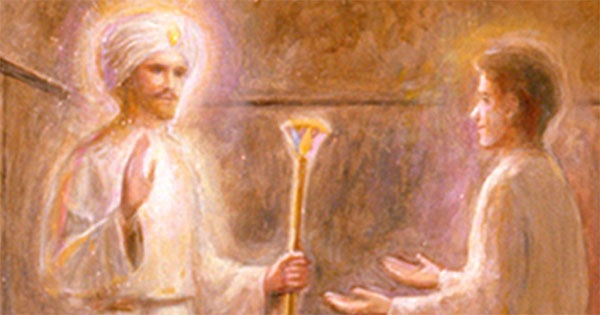Master Serapis Bey the Chohan of the fourth Ray

Serapis Bey is the Chohan of the fourth ray, hierarch of the Ascension Temple at Luxor, and the thirteenth member of the Council of Adepts of the Ascension Temple. He is also known as Serapis Soleil, Serapis of the Sun.
Serapis Bey, sometimes written as Serapis is regarded in Theosophy as being one of the Masters of the Ancient Wisdom; and in the Ascended Master Teachings is considered to be an Ascended Master and member of the Great White Brotherhood. He is regarded as the Chohan (or Lord) of the Fourth Ray. C. W. Leadbeater wrote that Henry Steel Olcott was given occult training by Serapis Beywhen his own master, Morya, was unavailable. A series of letters to Olcott, alleged to be from Serapis, encouraging Olcott to support Blavatsky in the founding of the Theosophical Society were published in the book Letters from the Masters of the Wisdom.
The fourth ray is the ascension flame, the white light of the Mother in the base of the spine chakra. Out of this white light comes architecture, the principles of mathematics, the foundations of the building of the Matter temple and the pyramid of Self.
In the presence of Serapis, one knows an entirely different conception of what we call the Christ, the real person of us all. Known as the Great Disciplinarian, Serapis came from Venus with the Ancient of Days to rekindle the sacred fire in the hearts of a wayward mankind. His great enthusiasm to reclaim the sons of man as kings and priests unto God swelled and mounted into a flame of iron will, determination and discipline.
He assists his students in the self disciplines that are necessary for the ascension: the discipline of the four lower bodies in order that the Christ may appear and use them as vehicles for service and attainment in the world of form; the disciplining of past momentums of negative spirals and of human creation that would stand in the way of the ascension flame forming within the heart of everyone evolving upon the planet through the acceleration of the threefold flame.
Guiseppe Verdi captured the music of the ascension flame in the Triumphal March from Aïda. The radiance of the electronic presence of Serapis Bey and his twin flame pour through the aria Celeste Aïda. The keynote of the Ascension Temple is Liebestraum by Franz Liszt.
Master Serapis Bey previous lifetimes
It is thought that Serapis Bey was incarnated as a high priest in one of the "Temples of the Sacred Fire" on Atlantis who migrated to Egypt at the time of the destruction of Atlantis.
King Leonidas is believed to have been born around 540 BC. Although little is known of his early life, the battle of Thermopylae that he waged against the Persians is one of the most famous battles of all time. In August of 480 BC, Leonidas, received a request from the Greeks to stand with them against an invasion by the Persians. Leonidas set out to meet the army of Xerxes, the Persian commander, with three hundred of his personal body guards. An army of 4,000 to 7,000 Greeks joined Leonidas. Together they battled a massive army of Persians estimated to be between 80,000 and 290,000 strong.
On the third day, the Spartans and Greeks were trapped from behind when a traitor led the Persians to a mountain track at the rear of the forces under Leonidas’ command. At that point, Leonidas sent away the Greeks and remained in the pass with only his 300 body guards and 1,600 other Spartans (Helots and Thesbians) who had joined them. The Spartans fought until every man, including Leonidas, had been slain but not until they had killed nearly 20,000 Persian soldiers. The Spartans’ sacrifice gave the Greek naval fleet time to retreat and later defeat the Persians in a battle at sea.
Amenhotep III is believed to have begun his rule at about the age of nine. It is likely that a relative acted as regent for him until he came of age. As an Egyptian Pharaoh, Amenhotep III, and his wife Tiye are known as the founders of monotheism in Egypt, a practice continued and expanded by one of Amenhotep’s sons, Akhenaten, an incarnation of the ascended master Lanello.1
One of Amenhotep III's first decisions upon taking the throne was to open two new limestone quarries. His extensive building projects included the construction of the temples at Luxor on the Nile and a large number of other projects in Nubia. He also initiated comprehensive building projects at the Temple of Karnak.
When Amenhotep III died, Egypt was a strong and powerful country with a great deal of influence in the international world. His son Akhenaten extended Amenhotep’s reformation of the many-faceted Egyptian religion, emphasizing the worship of one God, represented by the sun. Akhenaton reigned from 1417 to 1379 BC.
Serapis Bey was in past lives the Roman King Numa Pompilius, the philosophers Confucius, Plato and Lucius Anneus Seneca. He is referred in the book Supermundane as "The Thinker".
Sources:
- Bailey, A. A. (1995). The Seven Rays of Life. Lucis Publishing Companies.
- Bailey, A. A. (1971). Esoteric Psychology: A Treatise on the Seven Rays (Vol. Vol. 1). Lucis Publishing Company.
- Bailey, A. A. (1973). A Treatise on Cosmic Fire. Lucis Publishing Company.
